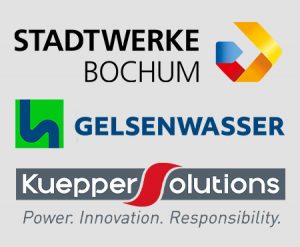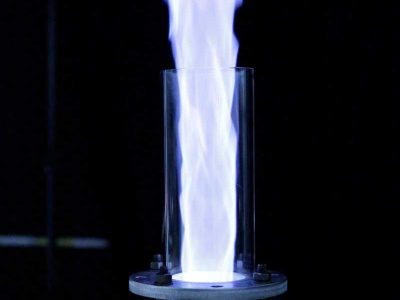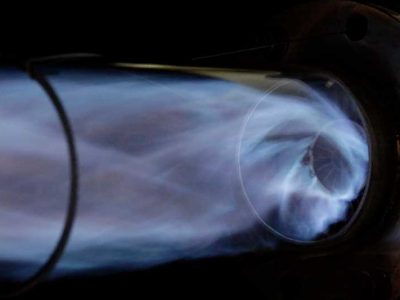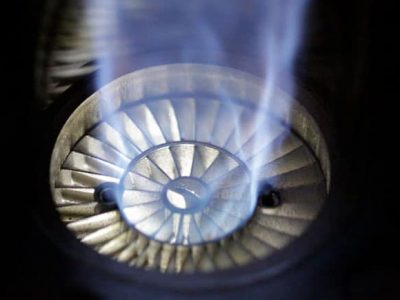
Kueppers Solutions has developed a new mixing unit for gas burners together with the Institute for Technical Combustion at RWTH Aachen University, the Gas and Heat Institute in Essen, the Chair for Energy Systems and Energy Process Technology at Ruhr University Bochum and the Chair for Digital Additive Production DAP at RWTH Aachen University. The innovative geometry of the mixing unit produced in 3D pressure produces a precisely dosed gas-air mixture that burns better and reduces the emission of nitrogen oxides.
In tests with the Gas and Heat Institute in Essen, Germany, we have demonstrated that our mixing unit can be used to build burners that, at 30 mg/Nm3, are more than 10 times below the current limit value. We achieve these values without secondary measures, such as the injection of urea into the exhaust gas, known as Ad Blue, SCR or SNCR, which is common in the automotive industry. Secondary measures clean the exhaust gas of nitrogen oxides, but always cost additional resources. We make sure that nitrogen oxides do not even occur in the first place.
This effect has a particularly positive effect on thermoprocessing systems with high exhaust gas temperatures: Here, the combustion air is preheated by heat exchangers with the energy of the exhaust gas. This significantly reduces the energy consumption of such plants. However, the nitrogen oxides rise sharply as a result of the combustion air preheating. Therefore, the energy of the exhaust gas is often not or only insufficiently used, although this measure could significantly improve the efficiency of the plant.
We commissioned the first reference plants at the beginning of 2019. However, the global gas market is too large to be developed by us alone. For this reason, we have been able to win cooperation partners for market development: Since the beginning of 2019, we have been cooperating with Gelsenwasser AG and Stadtwerke Bochum, both regional gas suppliers. The common goal is to supply the newly developed mixing unit as a supplier component to other burner manufacturers as well.

In this way, the technology can be used more quickly and across the board.
Our vision: We will become a supplier company comparable to the manufacturers of injection systems in the automotive industry. Well-known manufacturers buy mixing units for gaseous fuels from us. Because if nitrogen oxide emissions from industry are to be significantly reduced, thousands of industrial burners will have to be retrofitted.
In the field of industrial burners, certain dimensions and sizes have become established across manufacturers. Similar to replacing a light bulb with an energy-saving lamp, many burners in existing plants could therefore be replaced without having to replace the entire plant. Since thermoprocessing systems are used for 30 to 50 years, this option is particularly important.
How our mixing unit works
Which values are realistic?

The adjacent table shows the exhaust gas values achieved so far as a function of the average furnace chamber temperature (T average). As the furnace chamber temperature rises, the nitrogen oxides also rise, since the formation of nitrogen oxides during natural gas combustion is primarily dependent on the process temperature. Many thermoprocessing plants are operated in a temperature window between 800 and 1200°C. The temperature range is between 800 and 1200°C. As a rule, these plants have a nitrogen oxide limit value of 350 mg/Nm3 (milligrams per standard cubic meter) based on 3% oxygen in the exhaust gas.
We are currently intensively investigating whether further improvement of the exhaust gas values is possible. The adjacent table shows the status we are currently achieving with our mixing units.
“People with a new idea are considered crazy until the matter is settled.”
– Mark Twain
Our explanation videos illustrate the idea behind the whole. Have fun watching them.
Film 3: The Solution
Making-of: From the idea to the product
-

Development start
Together with the “Institute for Technical Combustion” of RWTH Aachen University, the company is developing a new mixing unit for industrial burners that can significantly reduce nitrogen oxide emissions from thermal process plants. The project is funded by the Federal Ministry of Economics and Energy on the basis of a resolution of the German Bundestag.
Our approach: The root system of a tree as a model for a multi-channel mixing unit?
-

The first prototype of the mixing unit is ready.
It is an SLS component made of stainless steel 1.4823. This material is weldable, highly corrosion resistant, highly acid resistant and the tolerances are less than 30 μm.

Various series of measurements are carried out.
With the first prototype, the first measurement series at the Gas and Heat Institute (GWI) in Essen are now starting.
Amazing results of the measurement series: Prototype No. 1 (up to 600 KW) has fallen below 45 mg/Nm3.
-

The second prototype is ready.
According to the current results, we have optimized our mixing unit and are now carrying out measurements with our second prototype.
The second series of measurements showed even better values: NOx of 25 mg/Nm3 instead of (permitted) 350 mg.
-

First series mixing unit (up to 150 KW) is produced
After almost two years of development and research, the time has finally come: We produce our first series mixing unit.
This is now being used by several different customers for their first reference prototype systems.
-

Stadtwerke Bochum and GELSENWASSER take a stake in Kueppers Solutions.
“Kueppers Solutions invests in a technology that reduces pollutants, saves energy and contributes to heat recovery. The special importance of natural gas as an energy source for climate protection and energy efficiency becomes clear”, emphasised Henning Deters, Chairman of the Executive Board of GELSENWASSER AG, at the conclusion of the transaction.
-

THERMPROCESS 2019: The first public product launch
At our stand in Hall 9/ E60, we will be comparing conventional burners and their corresponding counterparts with the new mixing unit. We will present our model series RooN SI and RooN SC in different performance classes, equipped with the new mixing unit. Of course with significantly improved exhaust values!
Photo gallery


















